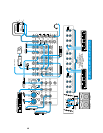
46
“XLR” CONNECTORS
Mackie mixers use 3-pin female “XLR” connec-
tors on all microphone inputs, with pin 1 wired to
the grounded shield, pin 2 wired to the “hot”
(positive polarity) side of the audio signal and
pin 3 wired to the “cold” (negative polarity) side
of the signal (Figure 7).
Use a male “XLR”-type connector, usually found
on the nether end of what is called a “mic cable,”
to connect to these inputs.
Mackie occasionally uses 3-pin male “XLRs” for
balanced line outputs. The Main L/R Outs on the
8•Bus, for example, are available on XLRs. These are
also wired pin 1 ground, pin 2 high and pin 3 low.
1/4" TRS PHONE PLUGS AND JACKS
“TRS” stands for Tip-Ring-Sleeve, the three
connections available on a “stereo” 1/4" phone
jack or plug (Figure 8). TRS jacks and plugs are
used in several different applications:
• Stereo headphones, and rarely, stereo micro-
phones and stereo line connections. When
wired for stereo, a 1/4" TRS jack or plug is
connected tip to left, ring to right and sleeve to
ground. Mackie mixers do not directly accept
1-plug-type stereo microphones. They must be
separated into a left cord and a right cord that
are plugged into two channels.
• Balanced mono circuits. When wired as a
balanced connector, a 1/4" TRS jack or plug is
connected tip to signal high, ring to signal low,
and sleeve to ground.
• Unbalanced Send/Return circuits. When
wired as send/
return connector,
a 1/4" TRS jack or
plug is connected
tip to signal send
(output from
mixer), ring to
signal return
(input back into
mixer), and
sleeve to ground.
1/4" TS PHONE
PLUGS AND
JACKS
“TS” stands for
Tip-Sleeve, the two
connections avail-
able on a “mono”
1/4" phone jack or
plug (Figure 9). TS jacks and plugs are used in
many different applications, always unbalanced.
The tip is connected to the audio signal and the
sleeve to ground. Some examples:
• Unbalanced microphones
• Electric guitars and electronic instruments
• Unbalanced line-level connections
SWITCHED 1/4" PHONE JACKS
1/4" phone jacks can incorporate switches that
are activated by inserting the plug. These switches
may open an insert loop in a circuit, change the
input routing of the signal or serve other func-
tions. The Mackie 8•Bus Series uses switches in
the channel and bus Insert Jacks, and in the
mono/stereo AUX Return Jacks. See Special
Mackie Connections on page 49. We also use these
switches to ground the inputs of most line level
ins/outs when nothing is plugged into them.
Figure 10 (below): RCA connector (Plugis Amateuris)
Figure 7 (above): XLR connectors (Exelaris Triptipus)
APPENDIX A: Connections
Female XLR
2
3
1
TIPSLEEVETIPSLEEVE
2
2
3
1
1
COMMON
COLD
HOT
COMMON
COLD
HOT
3
COMMON
COLD
HOT
Male XLR
ADD-ONS
SPECS
ETC.
Direct out with no signal interruption to master.
Insert only to first “click”
Channel Insert jack
Channel Insert jack
Channel Insert jack
Direct out with signal interruption to master.
Insert all the way in to the second “click”
For use as an effects loop.
(TIP = SEND to effect, RING = RETURN from effects)
MONO PLUG
MONO PLUG
STEREO
PLUG
SLEEVE
TIP
TIPSLEEVE
TIP
SLEEVE
SLEEVE
TIPSLEEVE
TIP
RING
RING
TIP
SLEEVERING
Figure 9: TS connectors (Plugis Biconnectorus)
Figure 8: TRS connectors (Plugis Triconnectorus)


















